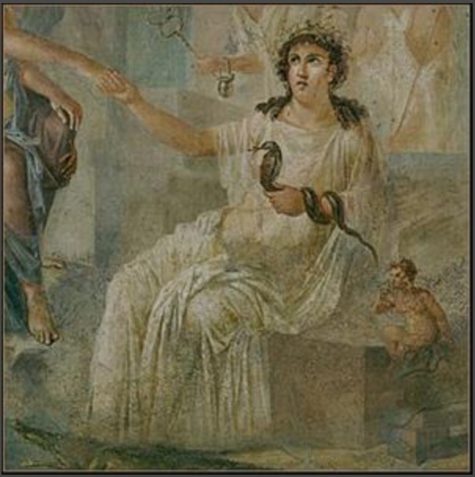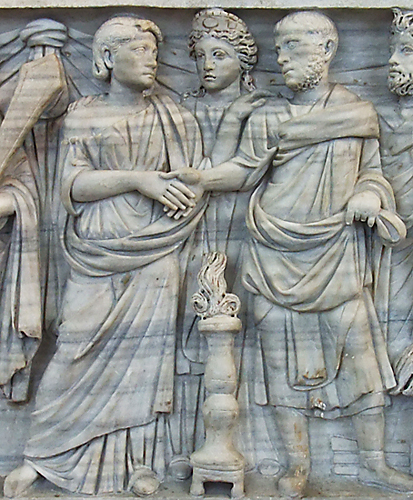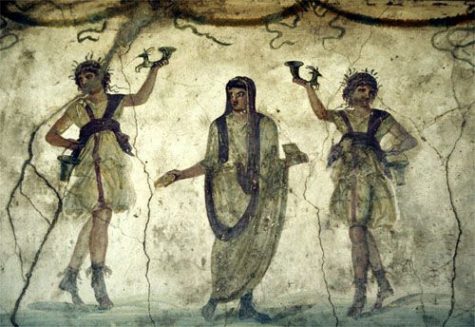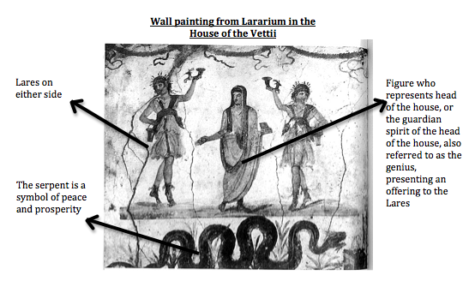Roman Gods and Goddesses
- Also known as: Bella Donna; Duellona
- Origin: Rome; possibly Etruscan
- Feast Day: June 3
Bellona, Goddess of War and Conquest, was once extremely popular with Roman soldiers. Roman senate meetings pertaining to foreign wars were conducted in Bellona’s temple on the Capitoline Hill.
Bellona’s name derives from the same root as bellicose and belligerent. Some consider it safer to call her Bella Donna. Bella Donna, literally “Beautiful Lady,” contains the name Bellona within it. It may be a euphemistic pun so that one could refer to Bellona without actually calling upon this beautiful but fierce lady.
Classical Roman mythology classifies Bellona, Lady of War, as belonging to the family of Mars. She is variously described as the wife or sister of Mars, less often his daughter, and sometimes his charioteer or nurse.
- Favored people: Soldiers, those who battle.
- Manifestation: A beautiful woman with long windswept hair, girded for battle.
- Attributes: Scourge; whip (to whip troops into frenzy); torch (to light her opponents’ funeral pyres).
- Sacred plant: Belladonna, (atropa belladonna), a beautiful but lethal killer, shares her essence.
- Sacred Sites: In addition to her Roman temple, Bellona had a temple outside York, England, and a shrine in Arfeuilles, France, now home of the Black Madonna of the Hollies. She was venerated wherever Roman soldiers traveled.
This goddess did not play a significant role in either myth or legend, and her worship appears to have been promoted in Rome chiefly by the family of the Claudii, whose Sabine origin, together with their use of the name of Nero, has suggested an identification of Bellona with the Sabine war goddess Nerio.
Her temple at Rome, dedicated by Appius Claudius Caecus (296 B.C.) in fulfillment of a a vow during the Third Samnite War with the Samnites and Etruscans, stood in the Campus Martius, near the Flaminian Circus and Porta Carmentalis (the Carmenta gate), and outside the gates of the city. It was there that the senate met to discuss a general’s claim to a triumph, and to receive ambassadors from foreign states. In front of it was the columna bellica, where the fetialis ceremony of declaring war was performed, in which a spear was cast against the distant enemy.
Note:
This native Italian goddess should not be mistaken for the Asiatic Bellona, whose worship was introduced into Rome apparently by Sulla, to whom she had appeared, urging him to march to Rome and bathe in the blood of his enemies. Her feast day was changed to the 24th of March, after the confusion of the Roman Bellona with her Asiatic namesake. See Day of Blood
Bona Dea (“The Good Goddess”) was a divinity in ancient Roman religion. She was associated with chastity and fertility in women, healing, and the protection of the Roman state and people. According to Roman literary sources, she was brought from Magna Graecia at some time during the early or middle Republic, and was given her own state cult on the Aventine Hill.
Bona Dea was worshipped only by women. In fact, the presence of a man at rites in her honor were a sacrilige. May 1 was the annual, state-sponsored festival to Bona Dea at her temple. In early December, there was another private festival as well.
Her rites allowed women the use of strong wine and blood-sacrifice, things otherwise forbidden them by Roman tradition. Men were barred from her mysteries and the possession of her true name. Given that male authors had limited knowledge of her rites and attributes, ancient speculations about her identity abound, among them that she was an aspect of Terra, Ops, the Magna Mater, or Ceres, or a Latin form of Damia. Most often, she was identified as the wife, sister or daughter of the god Faunus, thus an equivalent or aspect of the nature-goddess Fauna, who could prophesy the fates of women.
The Good Goddess was a patron of the good of the earth and of chastity and fertility in women, she was invoked for healing and for freedom from slavery. Many of her worshippers were freed slaves and plebians, and many were women seeking aid in sickness or for fertility. She was also considered a protector from earthquakes.
Bona Dea was sometimes depicted with a scepter, vine leaves, wine, and a serpent, usually curled around her arm. Sometimes she was depicted seated, holding a cornucopia. Her image appeared on many coins.
The temple to Bona Dea in Rome stood over an overhanging rock, or cave, and both serpents and healing herbs are associated with the cave. The temple contained many kinds of healing herbs and snakes (both associated with medicine). Men were not allowed in her temple or at her festivals, nor were male animals.
The temple was decorated with vine-branches, and other plants and flowers (although myrtle was not permitted). Wine was served, but it was referred to as “milk” and the jar in which it was served, a “honey-pot.” A sow was sacrificed to her at the ritual.
Another ceremony was held in December in honor of the Bona Dea. The rites were conducted annually by the wife of the senior magistrate present in Rome in his home. She was assisted by the Vestal Virgins. The December rite was interesting because unlike the festival in May, it was not held in the goddess’ temple, not paid for by the state and the night of its celebration was not fixed. Unlike the May celebration, the December ceremony was an invitation only affair and pretty exclusive.
The celebrations for the Bona Dea seem to have been in the nature of a mystery cult. Men were strictly forbidden and the details that we have of the ceremony are from a late source, Macrobius. The worship seems to have been agricultural in origin and the careful exclusion of myrtle (associated with flagellation) may actually suggest origins as a purification ceremony.
In the year 62 BCE, the celebration was held in the home of Julius Caesar, then praetor and Pontifex Maximus, on December 3rd. His wife Pompeia and his mother, Aurelia, were in charge. A notorious Roman politician, Publius Clodius, dressed up as a woman and sneaked into the house. He was eventually caught by Caesar’s mother and kicked out. The ceremony had to be performed anew.
Caesar divorced his wife over it (claiming even she had to be above suspicion). Publius Clodius was sued and at his trial Cicero blew his alibi. The two became mortal enemies over the affair. The rites seemed to have fallen into disrepute over the events, and by the early empire, Juvenal suggested that it was nothing but a drunken orgy for girls.
Collected from various sources including: Women’s History, Ancient History, and Wikipedia
Flora is the Roman Goddess of flowering plants, especially those that bear fruit. Spring, of course, is Her season, and She has elements of a Love-Goddess, with its attendant attributes of fertility, sex, and blossoming. She is quite ancient; the Sabines are said to have named a month for Her (which corresponds to our and the Roman April), and She was known among the Samnites as well as the Oscans, where She was called Flusia.
She was originally the Goddess specifically of the flowering crops, such as the grain or fruit-trees, and Her function was to make the grain, vegetables and trees bloom so that autumn’s harvest would be good. She was invoked to avert rust, a nasty fungal disease of plants that causes orange growths the exact color of rusting iron, and which was (is) an especial problem affecting wheat.
Hers is the beginning of the process that finds its completion with Pomona, the Goddess of Fruit and the Harvest; and like Pomona, Flora had Her own flamen, one of a small number of priests each in service to a specific Deity. The flamens were said to have been instituted by Numa, the legendary second King of Rome who succeeded Romulus; and whether Numa really existed or not, the flamens were undoubtedly of ancient origin, as were the Deities they served.
In later times Flora became the Goddess of all flowering plants, including the ornamental varieties. Her name is related to Latin floris, meaning naturally enough “a flower”, with the additional meaning of “[something] in its prime”; other related words have meanings like “prospering”, “flourishing”, “abounding”, and “fresh or blooming”.
In one story, Flora was said to have provided Juno with a magic flower that would allow Her to conceive with no help from a man; from this virgin-birth Mars was born. A late tale calls Flora a courtesan and gives Her a story similar to Acca Larentia: Flora was said to have made a fortune as a courtesan, which She bequeathed to Rome upon Her death, and for which She was honored with the festival of the Floralia. As Flora was originally a Sabine Goddess, and as the Sabines were a neighboring tribe whom the Romans conquered and assimilated into Rome, perhaps this is an acknowledgement of the land so acquired, put into legendary terms.
Flora had two temples in Rome, one near the Circus Maximus, the great “stadium” of Rome where chariot races were held, and another on the slopes of the Quirinal Hill. The temple on the Quirinal was most likely built on the site of an earlier altar to Her said to have been dedicated by Titus Tatius, King of the Sabines, who ruled alongside Romulus for a time in the very early (hence legendary) days of Rome. Her other temple was built quite near to the Circus Maximus, though its exact site has not been found, and was associated with a neighboring temple dedicated to the triad of Ceres (the Grain Goddess) and Liber and Libera (God and Goddess of the Vine). These Deities and Flora were all concerned with the fertility and health of the crops.
Flora’s temple by the Circus was dedicated on the 28th of April in 241 (or 248) BCE in response to a great drought at the command of the Sybilline books, and this day became the starting date of Her great festival, the Floralia. In Imperial times (1st century CE) this temple was rededicated (I assume after some restorations were made) on the 13th of August, and this date was given to a second festival of Flora, coinciding with the ripening of the grain, whose flowers She had set forth.
The Floralia of April was originally a moveable feast to coincide with the blossoming of the plants, later becoming fixed with the dedication of Her temple on the 28th (or 27th, before the calendar was reformed–I mention this because holidays were almost always held on odd-numbered days as it was considered unlucky to start a festival on an even-numbered day), though ludi or “games”–horse-races or athletic contests–were not held every year.
By the Empire the festival had grown (or should I say, blossomed) to seven days, and included chariot-races and theatrical performances, some of which were notoriously bawdy. It was given over to merriment and celebrations of an amorous nature, much like that northern flower-and-sex festival Beltaine whose date neatly coincides. Prostitutes considered it their own special time, and the Floralia gained a reputation as being more licentious and abandoned than the Saturnalia of December, whose name is legendary even now.
At the chariot-races and circus games of the Floralia it was traditional to let goats and hares loose, and lupines, bean-flowers and vetch (all of which have similarly-shaped blossoms and are a sort of showier version of wheat in bloom) were scattered, symbolic of fertility. Brightly colored clothes were a must, as were wreaths of flowers, especially roses; and the celebrations drew great crowds. Of the two nationalized chariot-teams who shared a deep rivalry, the Greens and the Blues, the Greens (of course) were Hers, and She had been invoked at chariot-races from ancient times.
The last day of the festival, May 3rd, was called Florae; it may be a special name for the closing day of the Floralia, or it may refer to a seperate ceremony conducted in Her temple on the Quirinal.
Flora was depicted by the Romans wearing light spring clothing, holding small bouquets of flowers, sometimes crowned with blossoms. Honey, made from flowers, is one of Her gifts, and Her name is said to be one of the secret (holy) names of Rome. She is sometimes called the handmaiden of Ceres. Ovid identifies Her with the Greek flower-nymph Chloris, whose name means “yellow or pale green”, the color of Spring. The word flora is still used as a general name for the plants of a region.
Alternate names/epithets: Flora Rustica, “Flora the Countrywoman” or “Flora of the Countryside”, and Flora Mater, or “Flora the Mother”, in respect to Her ancient origins. Among the Oscans She was known as Flusia.
Source: Thaliatook.com
In ancient Roman mythology, Salacia was the female divinity of the sea, worshiped as the goddess of salt water who presided over the depths of the ocean. She was the wife and queen of Neptune, god of the sea and water.
You can petition Salacia for safety on the sea, prosperity, abundance, and true love. She has powers of healing and fertility and access to all the treasures of the sea.
Her story is as follows:
The god Neptune wanted to marry Salacia, but she was in great awe of her distinguished suitor, and to preserve her virginity, with grace and celerity she managed to glide out of his sight, and hid from him in the Atlantic Ocean. The grieving Neptune sent a dolphin to look for her and persuade the fair nymph to come back and share his throne. Salacia agreed to marry Neptune and the King of the Deep was so overjoyed at these good tidings that the dolphin was awarded a place in the heavens, where he now forms a well known constellation Delphinus.
Salacia is represented as a beautiful nymph, crowned with seaweed, either enthroned beside Neptune or driving with him in a pearl shell chariot drawn by dolphins, sea-horses (hippocamps) or other fabulous creatures of the deep, and attended by Tritons and Nereids. She is dressed in queenly robes and has nets in her hair.
Salacia was the personification of the calm and sunlit aspect of the sea. Derived from Latin sal, meaning “salt”, the name Salacia denotes the wide, open sea, and is sometimes literally translated to mean sensational.
As his wife, Salacia bore Neptune three children, the most celebrated being Triton, whose body was half man and half fish.
Other names and titles:
Salacia Neptuni which means “effervescence of Neptune”.She was sometimes invoked by Roman priests as “maia Volcani, Salacia Neptuni, hora Quirini, nerio Martis.” As Salachia, she is also sometimes known as the goddess of springs, ruling over the springs of highly mineralized waters. She is identified with the Greek goddess, Amphitrite, wife of Poseidon who shares a similar mythology.
From: Wikipedia and other sources
Note: This post was put together by Shirley Twofeathers, you may repost and share it only if you give me credit and a link back to this website. Blessed be.
- Origin: Rome
- Meanings: With-the-Heart, Agreement, Synthesis of Minds
- Sacred To Her: Olive branch; Grass; Wandering Jew; Salt (as in ‘salt of the earth’); Museums.
- Animal: Stork, Dove
- Other Symbols: Cornucopia, Caduceus, Star (emblem of hope), Two clasped hands (handshake)
- Feast Days: Jan 16, Feb 22, July 22, Aug 22,
- Associated with: Pax, Salus, Securitas, Fortuna. She was also paired with Hercules and Mercury.
- Greek Personification: Goddess Homonoia, the Greek personification of harmony.
Iconography: Concordia is portrayed sitting or standing, wearing a long cloak and holding a sacrificial bowl or an olive branch in her left hand and a cornucopia in her right symbolizing the prosperity that comes with peace.. Sometimes she can be seen standing between two members of the Royal House who clasp hands.
About Concordia:
Concordia is the Roman Goddess of agreement and harmony. The sister of peaceful Pax, she’s very conciliatory and will do almost anything to avoid upsetting people.
She was also responsible for harmony in marriage, as revealed by her epithet Concordia Conjugalis. Other epithets include Concordia Augusta (harmony of the emperor), Concordia Militaris (harmony of the army), and Concordia Provinciarum (harmony of the provinces).
Concordia is one of the oldest of the Roman deities, having been worshipped since the earliest days of Rome. She was worshipped in many temples, but the oldest was on the Forum Romanum and dates back to 367 BCE and was built by Camilus. The temple also served as a meeting-place for the Roman senate. she had another temple nearby on the Capitoline Hill.
In ancient Roman religion, Concordia is the goddess who embodies agreement in marriage and society. Her Greek equivalent is usually regarded as Harmonia, with musical harmony a metaphor for an ideal of social concord or entente in the political discourse of the Republican era. She was thus often associated with Pax (“Peace”) in representing a stable society. As such, she is more closely related to the Greek concept of homonoia (likemindedness), which was also represented by a goddess.
Unlike many other Goddesses who were deified qualities, Concordia was worshiped from early times in Rome. She especially symbolized peace and agreement between the two classes of Rome, the plebeians or commoners, and the patricians or nobles.
Concordia had a place in the festival of the Caristia or Charistia (meaning “Pardoning”) of February 22nd, a holiday celebrated by families in which it was traditional to reconcile differences and to mend quarrels or feuds within the family. Concordia was invoked for Her powers of bringing harmony and agreement, and other Deities invoked at the Caristia were Janus, the double-faced God of New Beginnings, Salus, the Goddess of Health, and Pax, Goddess of Peace.
These four Divinities were honored with statues grouped together at the Altar of Peace (not the great big famous one built by Augustus, but a smaller one whose location is unknown). They were also said to be worshiped together on the 30th of March and the 30th of January, and Concordia was invoked by matrons on April 1st at the Veneralia, the festival of Venus Verticordia, along with Fortuna and Venus Herself.
In the later days of the Empire, Concordia was worshiped as the bringer of marital harmony within the imperial family, and as such was called Concordia Augusta.
She was depicted as a matronly woman, veiled and heavily draped, holding an olive branch, emblematic of peace, and a cornucopia, to symbolize the abundance that can be achieved when people work together in harmony. She sometimes wore a crown and held a sceptre, caduceus, or patera, a small offering bowl from which libations were poured.
She is associated with the stork, which symbolized family devotion to the Romans, and the dove, universally a symbol of peace and gentleness; and sometimes a star, as emblem of hope, is shown near Her. Another attribute of Concordia is the image of two clasped hands, both of which are right hands (like in a handshake), symbolizing two people agreeing. She is often shown on coins commemorating joint rule of leaders or the marriages of the imperial family.
Inscriptions on coins refer to different applications of Concordia; these were probably not epithets, but rather illustrations of types of harmony, but I list some of them here: Concordia Militaris, “the Harmony of Armies”, Concordia Provinciarum, “the Harmony of the Provinces”, Concordia Conjugalis, “Harmony of Marriage”.
Here is some history:
In the early days of Rome the two classes had joined to drive out the tyrannical Kings and created a Republic; but it quickly became a Republic of the patricians who had all the wealth and power. The plebeians were barred from the Senate and other governmental and priestly offices, though they of course made up most of the army. In 494 BCE the plebeians had had enough, and, refusing to serve in the army anymore, deserted and camped out on a hill near the Anio River that they called the Mons Sacer, or the Sacred Mountain. The patricians, left defenseless, came to some kind of sense and reforms were instituted giving the plebeians more rights.
To commemorate the compromises worked out between patricians and plebeians, a temple to Concordia was built in the northwestern end of the Roman Forum, backed up against the Capitoline Hill, near the Volcanal, a raised area that housed an altar to Vulcan. This temple was originally vowed in 367 BCE by the general Camillus and dedicated on July 22nd (which became Her festival) sometime afterwards. This temple was of somewhat unusual proportions due to the constraints of the site, but it was accorded one of the most beautiful in Rome, as it was finely made and entirely faced in marble. In later times it served as a museum of sorts, and many famous works of art were housed there.
Notes:
- More about her feast days: Pagan Calendar
- More information can be found at Thalia Took
- Also known as: Lases (Etruscan); Lassi
- Manifestation: Lares usually come in pairs, either in human form or as snakes.
- Sacred animal: Dog; Snake
- Origin: Italy
- Feast: Dec 23, The Larentalia
Lares are guardian spirits. Lares is plural but that’s fitting because they virtually always manifest in pairs. The singular is Lar. They are found inside the home, on the property they protect and also at crossroads. They make their home with the family they protect, usually dwelling by the hearth or beside the chimney.
The Lares themselves are usually depicted as dancing youths, with a horn cup in one hand and a bowl in the other. As progenitors of the family, they were accompanied by symbolic phallic serpents.
There were many different types of guardians. The most important are the Lares Familiares (guardians of the family), Lares Domestici (guardians of the house), Lares Patrii (guardians of the fathers) and Lares Privati (personal guardians). Other guardians were the Lares Permarini (guardians of the sea), Lares Rurales (guardians of the land), Lares Compitales (guardians of crossroads), Lares Viales (guardians of travelers) and Lares Praestitis (guardians of the state).
The Lar Familiaris protected all household members, free or slave, and was associated with a particular place, thus did not accompany a family who moved. Tradition holds that a family’s Lar would generously help those who honored him by devotionals and sacrifices. But the Lar would turn his back to those who would not offer him thanks or neglected him.
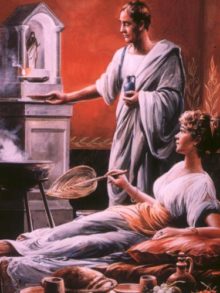 Presumed to be sons of Mercury and Lara, Lares are beneficent and friendly spirits, and deeply venerated by ancient Romans. In every house there was at least one little statue, and through these small statues, the Lare was presumed to take part in all that happened inside the house. Often a statue was put on the table during the meals, and other small statues were often placed in the higher places of the house, far from the floor, or even on the roof.
Presumed to be sons of Mercury and Lara, Lares are beneficent and friendly spirits, and deeply venerated by ancient Romans. In every house there was at least one little statue, and through these small statues, the Lare was presumed to take part in all that happened inside the house. Often a statue was put on the table during the meals, and other small statues were often placed in the higher places of the house, far from the floor, or even on the roof.
The Lares were worshiped in small sanctuaries or shrines, called Lararium, which could be found in every Roman house. They were placed in the atrium (the main room) or in the peristylium (a small open court) of the house. Here people sacrificed food to the Lares on holidays.
Care and attendance to domestic Lares could include offerings of spelt wheat and grain-garlands, honey cakes and honeycombs, grapes and first fruits, wine and incense. They could be served at any time and not always by intention: as well as the formal offerings that seem to have been their due, any food that fell to the floor during house banquets was theirs. On important occasions, wealthier households may have offered their own Lares a pig.
A household’s lararium, a shrine to the Lares Familiaris, usually stood near the hearth or in a corner of the atrium. A lararium often had the appearance of a cupboard or a niche containing a small statue, a niche painted on a wall, or a small freestanding shrine. Sometimes the Genius of the head of the household, pictured as a bearded or crested snake, or as a man with the fold of his toga covering his head, is depicted with the Lar.
Iconography: Lares are usually depicted as two young men with a watch dog; if depicted in serpentine form, then they may be crowned.
The Lares Compitales, the guardian spirits who protected local neighborhoods were housed in the crossroad shrines which served as a focus for the religious, social and political life of their local, overwhelmingly plebeian communities. Shrines were erected at crossroads. These shrines were usually open in all directions so that the Lares could travel as needed.
More about the Lares Compitales and their festival and feast days can be found here:
- Title: Lord of Beginnings
- Also known as: Giano, Dianus
- Origin: Roman
- Feast Day: January 9th, The Agonalia
- Tree: Oak
- Number: 1
- Time: Month of January
Janus is the two-faced spirit, but in the most positive sense of that term. Janus literally has two faces, indicating his power to see from all directions and perspectives. He sees the past and future simultaneously. Janus is a guardian and protector.
Janus is among the most ancient and significant deities of the Roman pantheon. He was in the Roman region long before the Romans arrived. Before the arrival of Jupiter, he may have been the preeminent male spirit. Officially superseded by Jupiter within the context of the Roman pantheon, Janus retained his right to be first.
Similar to modern traditions involving Eshu Elegbara, Janus is the first spirit invoked before any invocations, sacrifices, or offerings made to other Roman Deities. Jupiter then follows as “king,” followed by whomever else might be invoked.
The Roman Temple of Janus had double doors, known as the Gates of War. The temple was a visible symbol of peace or war. When there was peace throughout Rome, the doors of his temple were shut. This was a rare occurence.
In 153 BCE, the Romans changed their calendar, moving the New Year from the spring equinox to January 1st, one of the feast days of Janus, Spirit of Beginnings. With one face, Janus looks back on the old year; with the other he looks forward to the new. Roman New Year’s rituals incorporating the feast of Janus lasted for six days of joyous, raucous celebrating. Festivities included drinking, feasting, and decorating homes and buildings with holly, mistletoe, and lights.
- Invoke Janus when you wish to begin anew, when you need to make a fresh start.
- Invoke him before beginning new projects, ventures, and relationships.
- Invoke him to understand the past.
Favored People: Diviners; he seems to like pretty women, too.
Iconography: Janus has two faces: one looking forward, the other back. Sometimes one face is young; the other old.
Consort: His original consort seems to have been Jana (Diana), but he was eventually paired with Juturna.
Sacred site: The Janiculum Hill in Western Rome, center of his veneration.
Offerings: His traditional Roman offering was whole grain farro wheat mixed with salt, also Ianual, a type of focaccia (flat, oven-baked Italian bread) made with flour, eggs, oil, and cheese served during rituals thanking Janus for providing a bountiful harvest.
Source: Encyclopedia of Spirits

